Financial Performance Management Report: Tools, Techniques, and KPIs
VerifiedAdded on 2023/01/03
|12
|3889
|70
Report
AI Summary
This report provides a detailed analysis of financial performance management, focusing on environmental costs and the tools and techniques used by management accountants. Part 1 examines the challenges firms face in managing environmental costs and the methods used for accounting, including cost-benefit analysis and the identification and recording of environmental expenses. Part 2 delves into the decision-making process, planning tools such as forecasting and scenario planning, and the implementation of key performance indicators (KPIs) to improve financial performance. The report explores the importance of financial stability, budgetary control, and the role of management accountants in providing accurate information for effective decision-making. The report covers the importance of financial stability, budgetary control, and the role of management accountants in providing accurate information for effective decision-making.
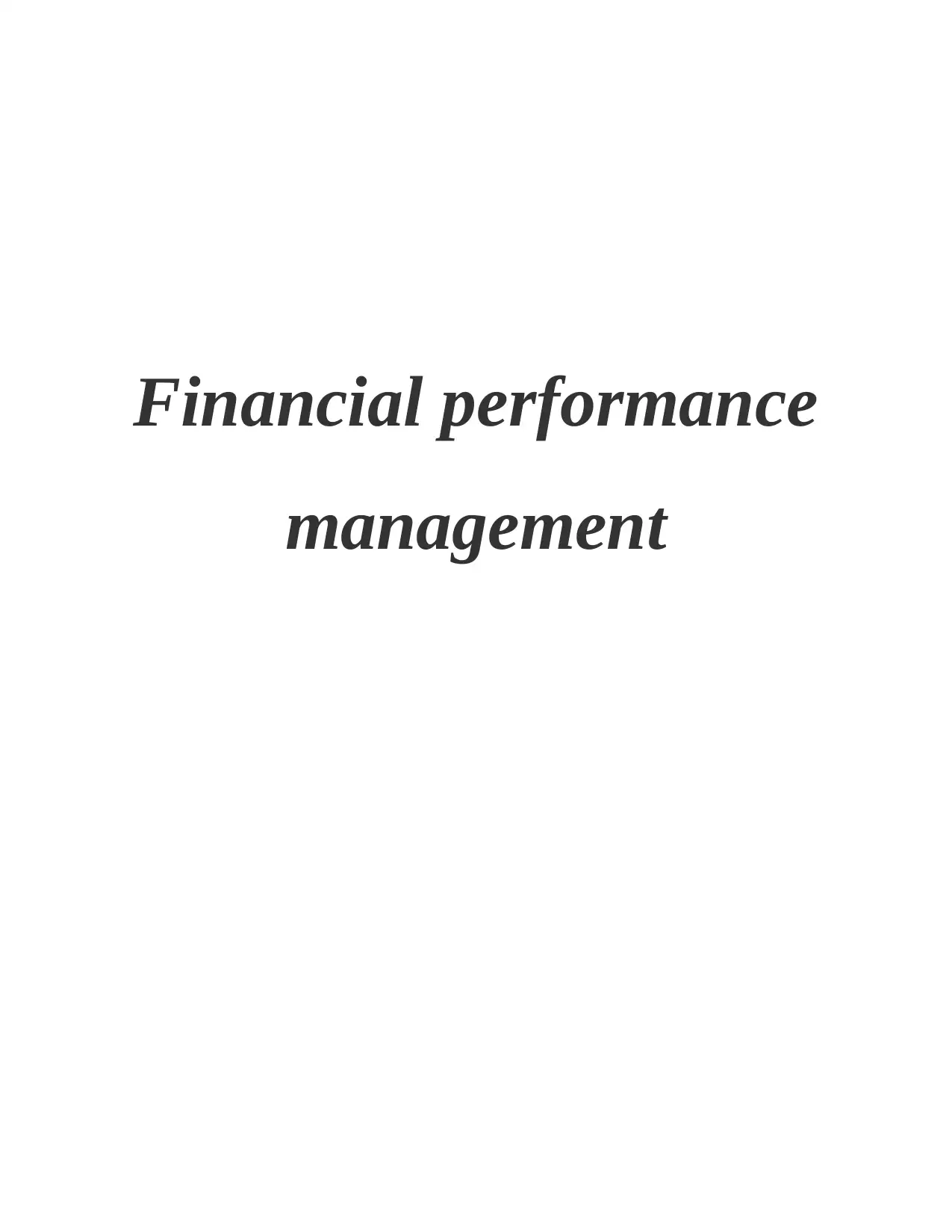
Financial performance
management
management
Paraphrase This Document
Need a fresh take? Get an instant paraphrase of this document with our AI Paraphraser
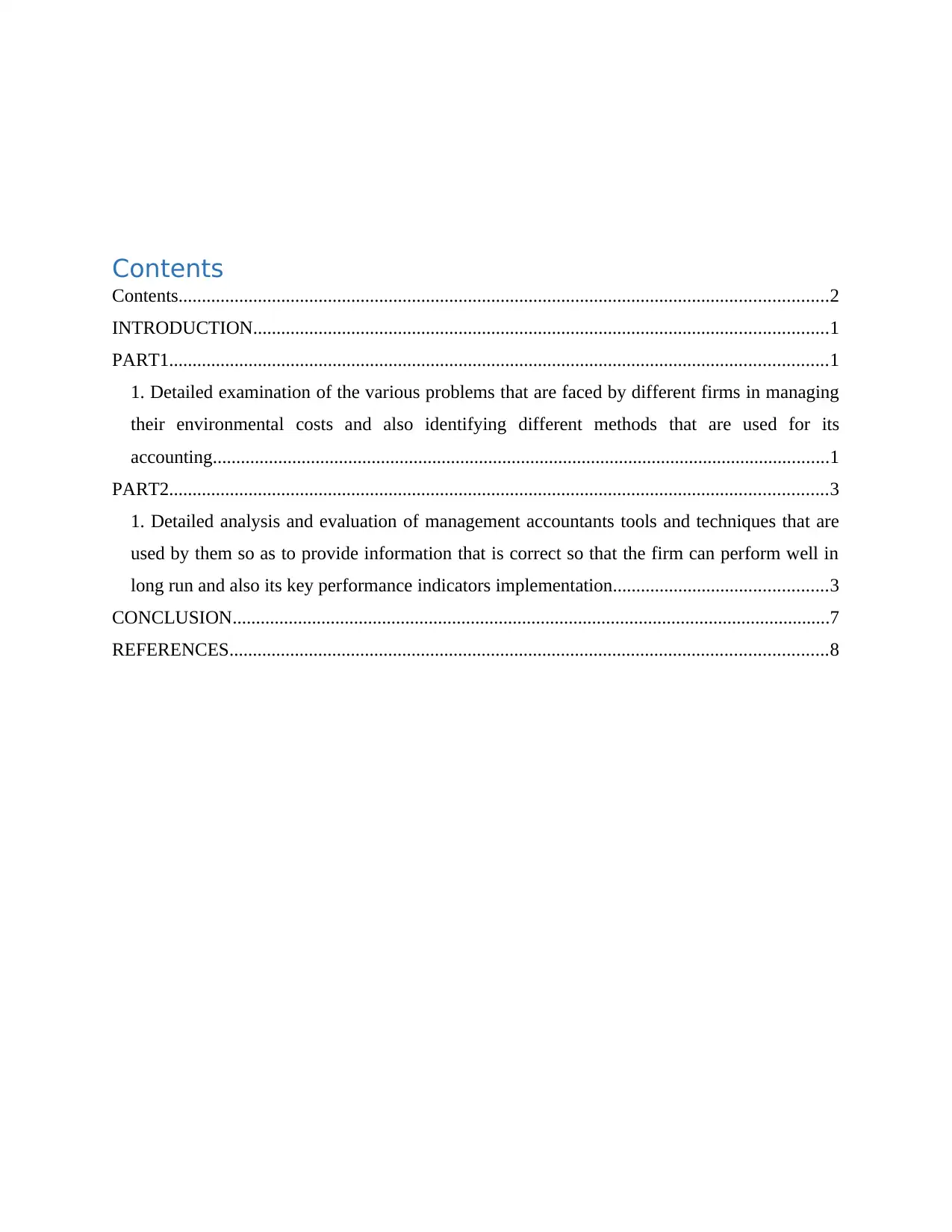
Contents
Contents...........................................................................................................................................2
INTRODUCTION...........................................................................................................................1
PART1.............................................................................................................................................1
1. Detailed examination of the various problems that are faced by different firms in managing
their environmental costs and also identifying different methods that are used for its
accounting....................................................................................................................................1
PART2.............................................................................................................................................3
1. Detailed analysis and evaluation of management accountants tools and techniques that are
used by them so as to provide information that is correct so that the firm can perform well in
long run and also its key performance indicators implementation..............................................3
CONCLUSION................................................................................................................................7
REFERENCES................................................................................................................................8
Contents...........................................................................................................................................2
INTRODUCTION...........................................................................................................................1
PART1.............................................................................................................................................1
1. Detailed examination of the various problems that are faced by different firms in managing
their environmental costs and also identifying different methods that are used for its
accounting....................................................................................................................................1
PART2.............................................................................................................................................3
1. Detailed analysis and evaluation of management accountants tools and techniques that are
used by them so as to provide information that is correct so that the firm can perform well in
long run and also its key performance indicators implementation..............................................3
CONCLUSION................................................................................................................................7
REFERENCES................................................................................................................................8

⊘ This is a preview!⊘
Do you want full access?
Subscribe today to unlock all pages.

Trusted by 1+ million students worldwide
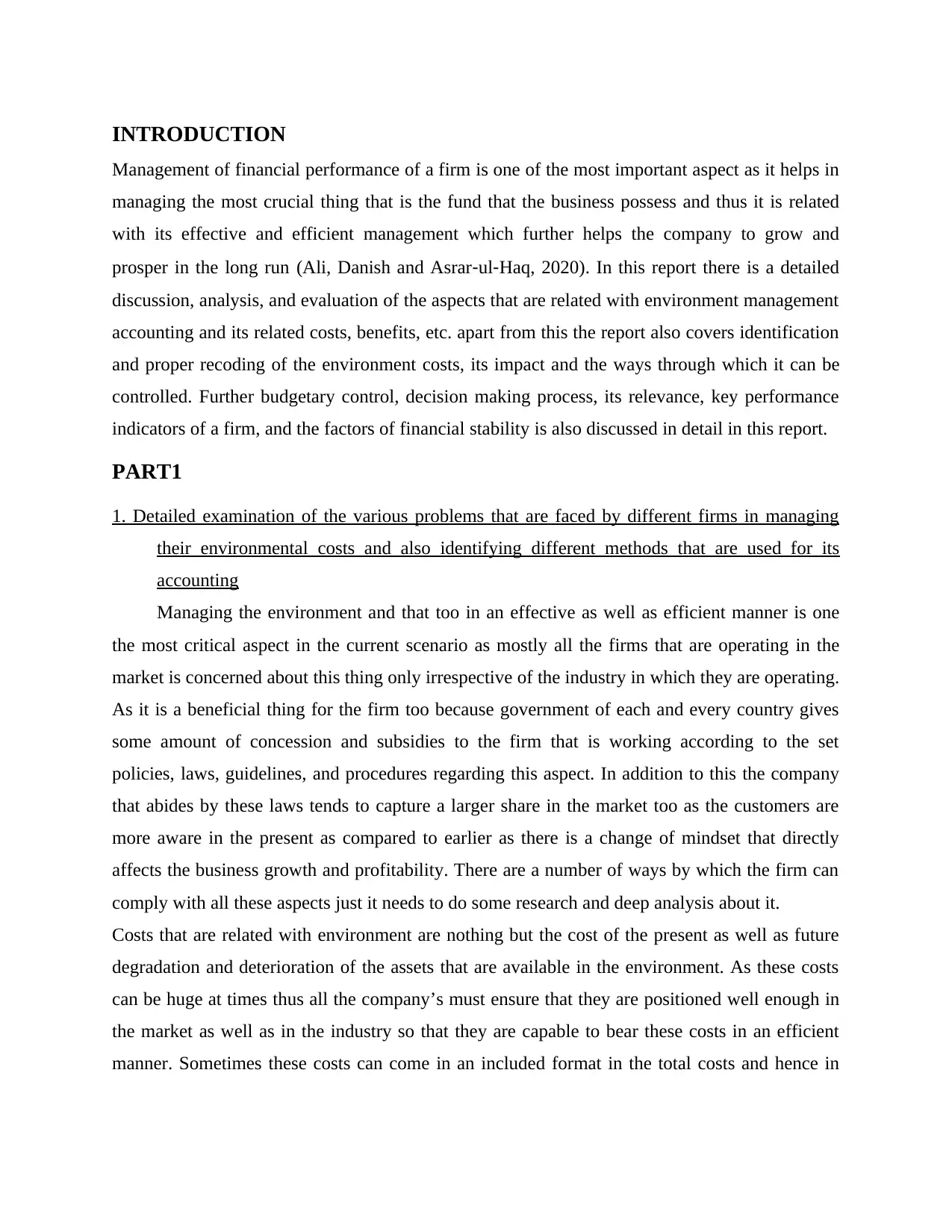
INTRODUCTION
Management of financial performance of a firm is one of the most important aspect as it helps in
managing the most crucial thing that is the fund that the business possess and thus it is related
with its effective and efficient management which further helps the company to grow and
prosper in the long run (Ali, Danish and Asrar‐ul‐Haq, 2020). In this report there is a detailed
discussion, analysis, and evaluation of the aspects that are related with environment management
accounting and its related costs, benefits, etc. apart from this the report also covers identification
and proper recoding of the environment costs, its impact and the ways through which it can be
controlled. Further budgetary control, decision making process, its relevance, key performance
indicators of a firm, and the factors of financial stability is also discussed in detail in this report.
PART1
1. Detailed examination of the various problems that are faced by different firms in managing
their environmental costs and also identifying different methods that are used for its
accounting
Managing the environment and that too in an effective as well as efficient manner is one
the most critical aspect in the current scenario as mostly all the firms that are operating in the
market is concerned about this thing only irrespective of the industry in which they are operating.
As it is a beneficial thing for the firm too because government of each and every country gives
some amount of concession and subsidies to the firm that is working according to the set
policies, laws, guidelines, and procedures regarding this aspect. In addition to this the company
that abides by these laws tends to capture a larger share in the market too as the customers are
more aware in the present as compared to earlier as there is a change of mindset that directly
affects the business growth and profitability. There are a number of ways by which the firm can
comply with all these aspects just it needs to do some research and deep analysis about it.
Costs that are related with environment are nothing but the cost of the present as well as future
degradation and deterioration of the assets that are available in the environment. As these costs
can be huge at times thus all the company’s must ensure that they are positioned well enough in
the market as well as in the industry so that they are capable to bear these costs in an efficient
manner. Sometimes these costs can come in an included format in the total costs and hence in
Management of financial performance of a firm is one of the most important aspect as it helps in
managing the most crucial thing that is the fund that the business possess and thus it is related
with its effective and efficient management which further helps the company to grow and
prosper in the long run (Ali, Danish and Asrar‐ul‐Haq, 2020). In this report there is a detailed
discussion, analysis, and evaluation of the aspects that are related with environment management
accounting and its related costs, benefits, etc. apart from this the report also covers identification
and proper recoding of the environment costs, its impact and the ways through which it can be
controlled. Further budgetary control, decision making process, its relevance, key performance
indicators of a firm, and the factors of financial stability is also discussed in detail in this report.
PART1
1. Detailed examination of the various problems that are faced by different firms in managing
their environmental costs and also identifying different methods that are used for its
accounting
Managing the environment and that too in an effective as well as efficient manner is one
the most critical aspect in the current scenario as mostly all the firms that are operating in the
market is concerned about this thing only irrespective of the industry in which they are operating.
As it is a beneficial thing for the firm too because government of each and every country gives
some amount of concession and subsidies to the firm that is working according to the set
policies, laws, guidelines, and procedures regarding this aspect. In addition to this the company
that abides by these laws tends to capture a larger share in the market too as the customers are
more aware in the present as compared to earlier as there is a change of mindset that directly
affects the business growth and profitability. There are a number of ways by which the firm can
comply with all these aspects just it needs to do some research and deep analysis about it.
Costs that are related with environment are nothing but the cost of the present as well as future
degradation and deterioration of the assets that are available in the environment. As these costs
can be huge at times thus all the company’s must ensure that they are positioned well enough in
the market as well as in the industry so that they are capable to bear these costs in an efficient
manner. Sometimes these costs can come in an included format in the total costs and hence in
Paraphrase This Document
Need a fresh take? Get an instant paraphrase of this document with our AI Paraphraser
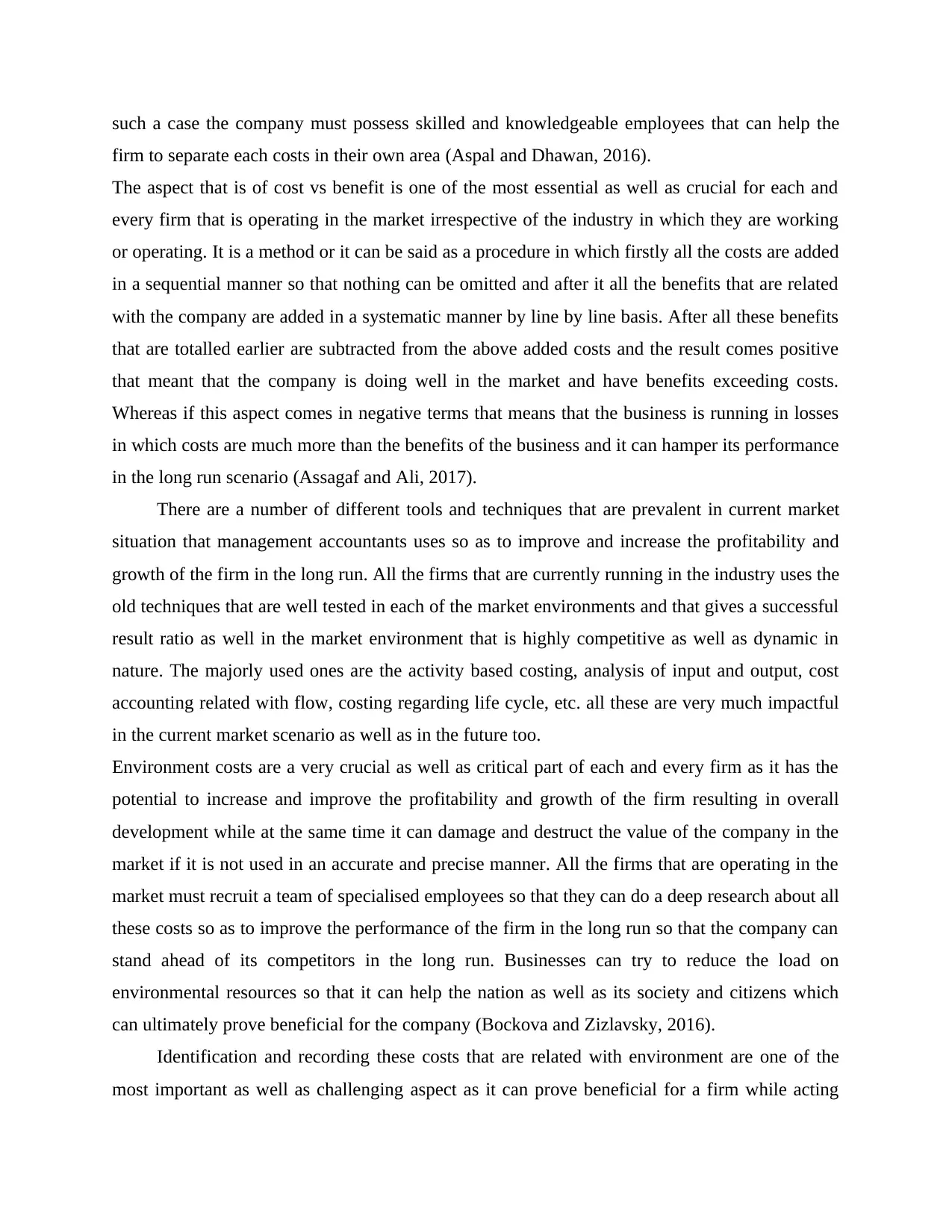
such a case the company must possess skilled and knowledgeable employees that can help the
firm to separate each costs in their own area (Aspal and Dhawan, 2016).
The aspect that is of cost vs benefit is one of the most essential as well as crucial for each and
every firm that is operating in the market irrespective of the industry in which they are working
or operating. It is a method or it can be said as a procedure in which firstly all the costs are added
in a sequential manner so that nothing can be omitted and after it all the benefits that are related
with the company are added in a systematic manner by line by line basis. After all these benefits
that are totalled earlier are subtracted from the above added costs and the result comes positive
that meant that the company is doing well in the market and have benefits exceeding costs.
Whereas if this aspect comes in negative terms that means that the business is running in losses
in which costs are much more than the benefits of the business and it can hamper its performance
in the long run scenario (Assagaf and Ali, 2017).
There are a number of different tools and techniques that are prevalent in current market
situation that management accountants uses so as to improve and increase the profitability and
growth of the firm in the long run. All the firms that are currently running in the industry uses the
old techniques that are well tested in each of the market environments and that gives a successful
result ratio as well in the market environment that is highly competitive as well as dynamic in
nature. The majorly used ones are the activity based costing, analysis of input and output, cost
accounting related with flow, costing regarding life cycle, etc. all these are very much impactful
in the current market scenario as well as in the future too.
Environment costs are a very crucial as well as critical part of each and every firm as it has the
potential to increase and improve the profitability and growth of the firm resulting in overall
development while at the same time it can damage and destruct the value of the company in the
market if it is not used in an accurate and precise manner. All the firms that are operating in the
market must recruit a team of specialised employees so that they can do a deep research about all
these costs so as to improve the performance of the firm in the long run so that the company can
stand ahead of its competitors in the long run. Businesses can try to reduce the load on
environmental resources so that it can help the nation as well as its society and citizens which
can ultimately prove beneficial for the company (Bockova and Zizlavsky, 2016).
Identification and recording these costs that are related with environment are one of the
most important as well as challenging aspect as it can prove beneficial for a firm while acting
firm to separate each costs in their own area (Aspal and Dhawan, 2016).
The aspect that is of cost vs benefit is one of the most essential as well as crucial for each and
every firm that is operating in the market irrespective of the industry in which they are working
or operating. It is a method or it can be said as a procedure in which firstly all the costs are added
in a sequential manner so that nothing can be omitted and after it all the benefits that are related
with the company are added in a systematic manner by line by line basis. After all these benefits
that are totalled earlier are subtracted from the above added costs and the result comes positive
that meant that the company is doing well in the market and have benefits exceeding costs.
Whereas if this aspect comes in negative terms that means that the business is running in losses
in which costs are much more than the benefits of the business and it can hamper its performance
in the long run scenario (Assagaf and Ali, 2017).
There are a number of different tools and techniques that are prevalent in current market
situation that management accountants uses so as to improve and increase the profitability and
growth of the firm in the long run. All the firms that are currently running in the industry uses the
old techniques that are well tested in each of the market environments and that gives a successful
result ratio as well in the market environment that is highly competitive as well as dynamic in
nature. The majorly used ones are the activity based costing, analysis of input and output, cost
accounting related with flow, costing regarding life cycle, etc. all these are very much impactful
in the current market scenario as well as in the future too.
Environment costs are a very crucial as well as critical part of each and every firm as it has the
potential to increase and improve the profitability and growth of the firm resulting in overall
development while at the same time it can damage and destruct the value of the company in the
market if it is not used in an accurate and precise manner. All the firms that are operating in the
market must recruit a team of specialised employees so that they can do a deep research about all
these costs so as to improve the performance of the firm in the long run so that the company can
stand ahead of its competitors in the long run. Businesses can try to reduce the load on
environmental resources so that it can help the nation as well as its society and citizens which
can ultimately prove beneficial for the company (Bockova and Zizlavsky, 2016).
Identification and recording these costs that are related with environment are one of the
most important as well as challenging aspect as it can prove beneficial for a firm while acting
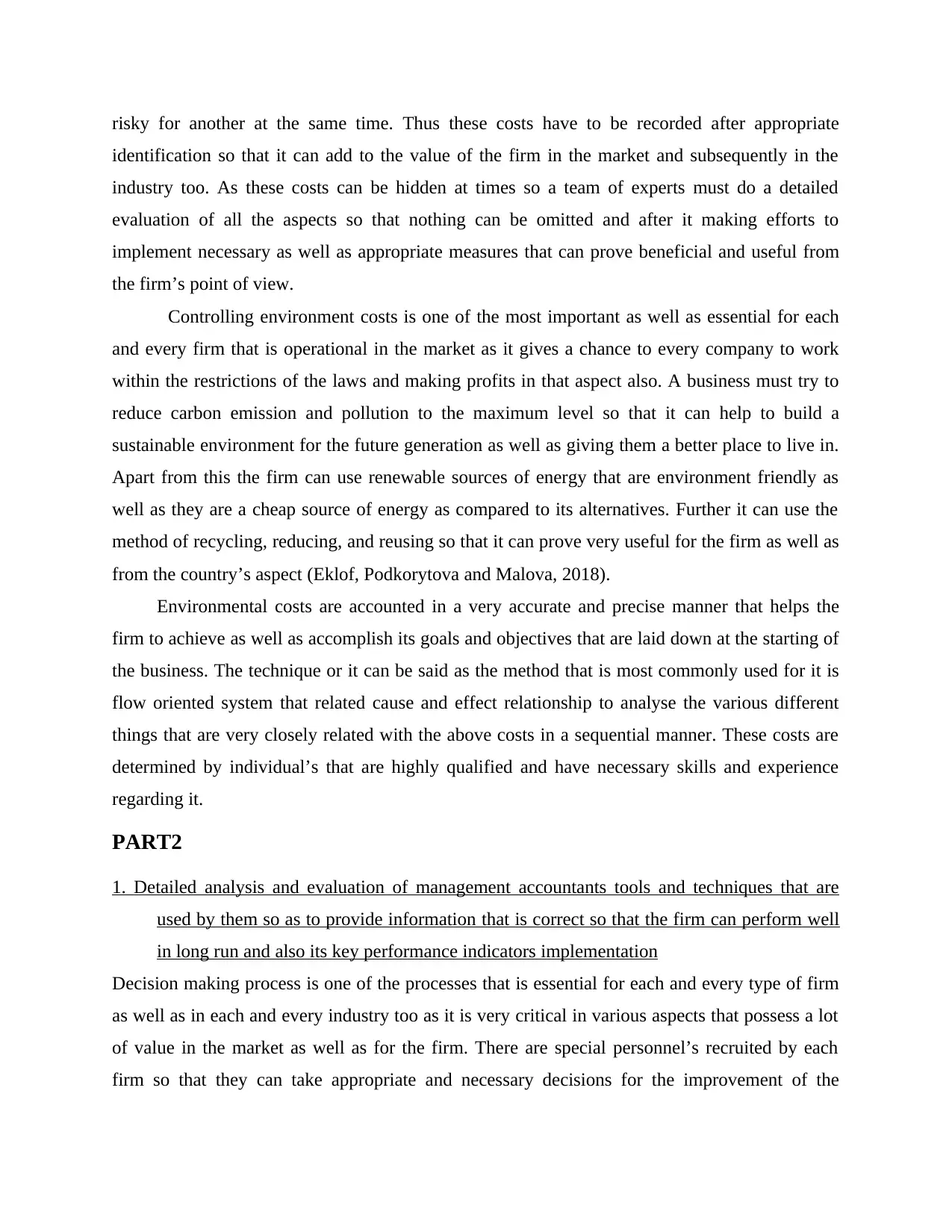
risky for another at the same time. Thus these costs have to be recorded after appropriate
identification so that it can add to the value of the firm in the market and subsequently in the
industry too. As these costs can be hidden at times so a team of experts must do a detailed
evaluation of all the aspects so that nothing can be omitted and after it making efforts to
implement necessary as well as appropriate measures that can prove beneficial and useful from
the firm’s point of view.
Controlling environment costs is one of the most important as well as essential for each
and every firm that is operational in the market as it gives a chance to every company to work
within the restrictions of the laws and making profits in that aspect also. A business must try to
reduce carbon emission and pollution to the maximum level so that it can help to build a
sustainable environment for the future generation as well as giving them a better place to live in.
Apart from this the firm can use renewable sources of energy that are environment friendly as
well as they are a cheap source of energy as compared to its alternatives. Further it can use the
method of recycling, reducing, and reusing so that it can prove very useful for the firm as well as
from the country’s aspect (Eklof, Podkorytova and Malova, 2018).
Environmental costs are accounted in a very accurate and precise manner that helps the
firm to achieve as well as accomplish its goals and objectives that are laid down at the starting of
the business. The technique or it can be said as the method that is most commonly used for it is
flow oriented system that related cause and effect relationship to analyse the various different
things that are very closely related with the above costs in a sequential manner. These costs are
determined by individual’s that are highly qualified and have necessary skills and experience
regarding it.
PART2
1. Detailed analysis and evaluation of management accountants tools and techniques that are
used by them so as to provide information that is correct so that the firm can perform well
in long run and also its key performance indicators implementation
Decision making process is one of the processes that is essential for each and every type of firm
as well as in each and every industry too as it is very critical in various aspects that possess a lot
of value in the market as well as for the firm. There are special personnel’s recruited by each
firm so that they can take appropriate and necessary decisions for the improvement of the
identification so that it can add to the value of the firm in the market and subsequently in the
industry too. As these costs can be hidden at times so a team of experts must do a detailed
evaluation of all the aspects so that nothing can be omitted and after it making efforts to
implement necessary as well as appropriate measures that can prove beneficial and useful from
the firm’s point of view.
Controlling environment costs is one of the most important as well as essential for each
and every firm that is operational in the market as it gives a chance to every company to work
within the restrictions of the laws and making profits in that aspect also. A business must try to
reduce carbon emission and pollution to the maximum level so that it can help to build a
sustainable environment for the future generation as well as giving them a better place to live in.
Apart from this the firm can use renewable sources of energy that are environment friendly as
well as they are a cheap source of energy as compared to its alternatives. Further it can use the
method of recycling, reducing, and reusing so that it can prove very useful for the firm as well as
from the country’s aspect (Eklof, Podkorytova and Malova, 2018).
Environmental costs are accounted in a very accurate and precise manner that helps the
firm to achieve as well as accomplish its goals and objectives that are laid down at the starting of
the business. The technique or it can be said as the method that is most commonly used for it is
flow oriented system that related cause and effect relationship to analyse the various different
things that are very closely related with the above costs in a sequential manner. These costs are
determined by individual’s that are highly qualified and have necessary skills and experience
regarding it.
PART2
1. Detailed analysis and evaluation of management accountants tools and techniques that are
used by them so as to provide information that is correct so that the firm can perform well
in long run and also its key performance indicators implementation
Decision making process is one of the processes that is essential for each and every type of firm
as well as in each and every industry too as it is very critical in various aspects that possess a lot
of value in the market as well as for the firm. There are special personnel’s recruited by each
firm so that they can take appropriate and necessary decisions for the improvement of the
⊘ This is a preview!⊘
Do you want full access?
Subscribe today to unlock all pages.

Trusted by 1+ million students worldwide
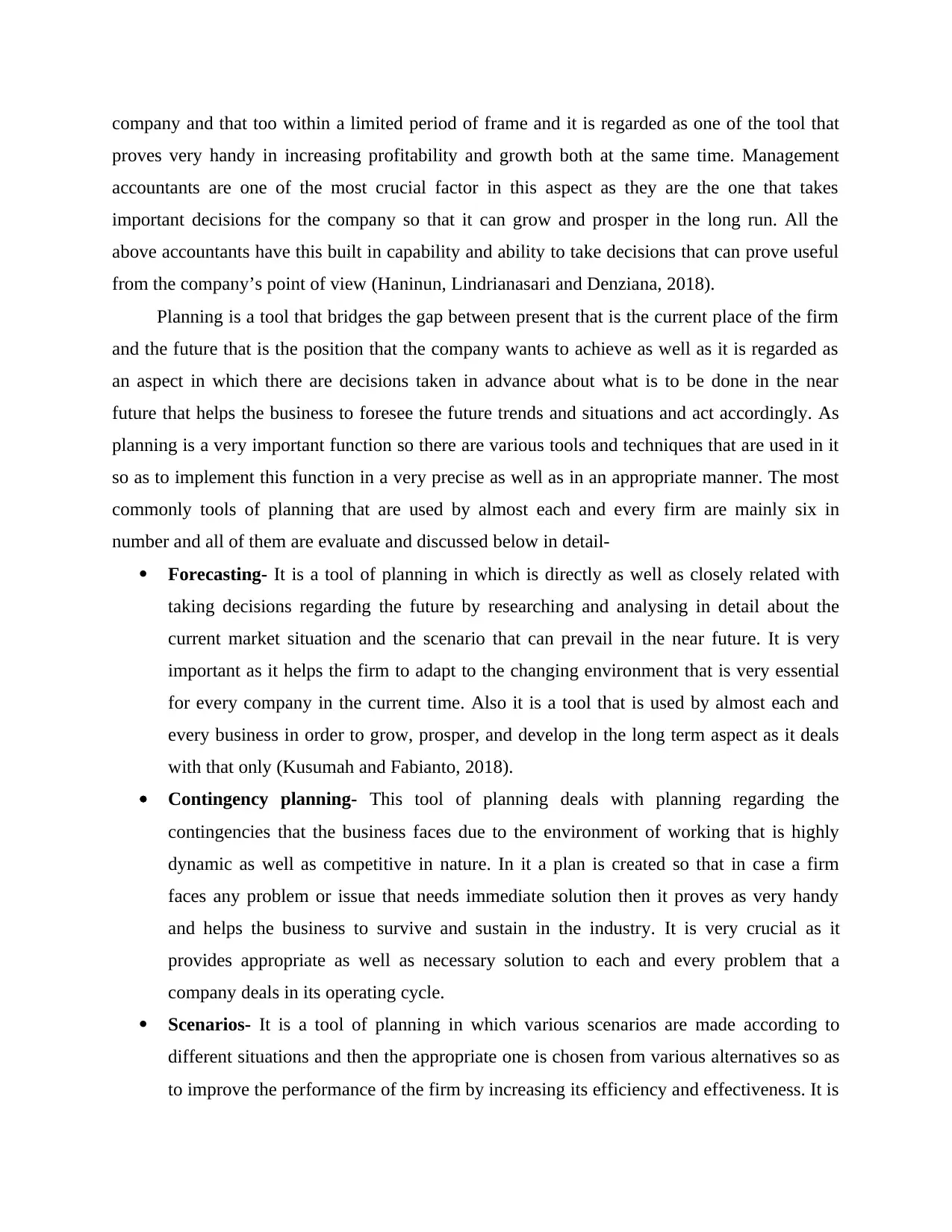
company and that too within a limited period of frame and it is regarded as one of the tool that
proves very handy in increasing profitability and growth both at the same time. Management
accountants are one of the most crucial factor in this aspect as they are the one that takes
important decisions for the company so that it can grow and prosper in the long run. All the
above accountants have this built in capability and ability to take decisions that can prove useful
from the company’s point of view (Haninun, Lindrianasari and Denziana, 2018).
Planning is a tool that bridges the gap between present that is the current place of the firm
and the future that is the position that the company wants to achieve as well as it is regarded as
an aspect in which there are decisions taken in advance about what is to be done in the near
future that helps the business to foresee the future trends and situations and act accordingly. As
planning is a very important function so there are various tools and techniques that are used in it
so as to implement this function in a very precise as well as in an appropriate manner. The most
commonly tools of planning that are used by almost each and every firm are mainly six in
number and all of them are evaluate and discussed below in detail-
Forecasting- It is a tool of planning in which is directly as well as closely related with
taking decisions regarding the future by researching and analysing in detail about the
current market situation and the scenario that can prevail in the near future. It is very
important as it helps the firm to adapt to the changing environment that is very essential
for every company in the current time. Also it is a tool that is used by almost each and
every business in order to grow, prosper, and develop in the long term aspect as it deals
with that only (Kusumah and Fabianto, 2018).
Contingency planning- This tool of planning deals with planning regarding the
contingencies that the business faces due to the environment of working that is highly
dynamic as well as competitive in nature. In it a plan is created so that in case a firm
faces any problem or issue that needs immediate solution then it proves as very handy
and helps the business to survive and sustain in the industry. It is very crucial as it
provides appropriate as well as necessary solution to each and every problem that a
company deals in its operating cycle.
Scenarios- It is a tool of planning in which various scenarios are made according to
different situations and then the appropriate one is chosen from various alternatives so as
to improve the performance of the firm by increasing its efficiency and effectiveness. It is
proves very handy in increasing profitability and growth both at the same time. Management
accountants are one of the most crucial factor in this aspect as they are the one that takes
important decisions for the company so that it can grow and prosper in the long run. All the
above accountants have this built in capability and ability to take decisions that can prove useful
from the company’s point of view (Haninun, Lindrianasari and Denziana, 2018).
Planning is a tool that bridges the gap between present that is the current place of the firm
and the future that is the position that the company wants to achieve as well as it is regarded as
an aspect in which there are decisions taken in advance about what is to be done in the near
future that helps the business to foresee the future trends and situations and act accordingly. As
planning is a very important function so there are various tools and techniques that are used in it
so as to implement this function in a very precise as well as in an appropriate manner. The most
commonly tools of planning that are used by almost each and every firm are mainly six in
number and all of them are evaluate and discussed below in detail-
Forecasting- It is a tool of planning in which is directly as well as closely related with
taking decisions regarding the future by researching and analysing in detail about the
current market situation and the scenario that can prevail in the near future. It is very
important as it helps the firm to adapt to the changing environment that is very essential
for every company in the current time. Also it is a tool that is used by almost each and
every business in order to grow, prosper, and develop in the long term aspect as it deals
with that only (Kusumah and Fabianto, 2018).
Contingency planning- This tool of planning deals with planning regarding the
contingencies that the business faces due to the environment of working that is highly
dynamic as well as competitive in nature. In it a plan is created so that in case a firm
faces any problem or issue that needs immediate solution then it proves as very handy
and helps the business to survive and sustain in the industry. It is very crucial as it
provides appropriate as well as necessary solution to each and every problem that a
company deals in its operating cycle.
Scenarios- It is a tool of planning in which various scenarios are made according to
different situations and then the appropriate one is chosen from various alternatives so as
to improve the performance of the firm by increasing its efficiency and effectiveness. It is
Paraphrase This Document
Need a fresh take? Get an instant paraphrase of this document with our AI Paraphraser
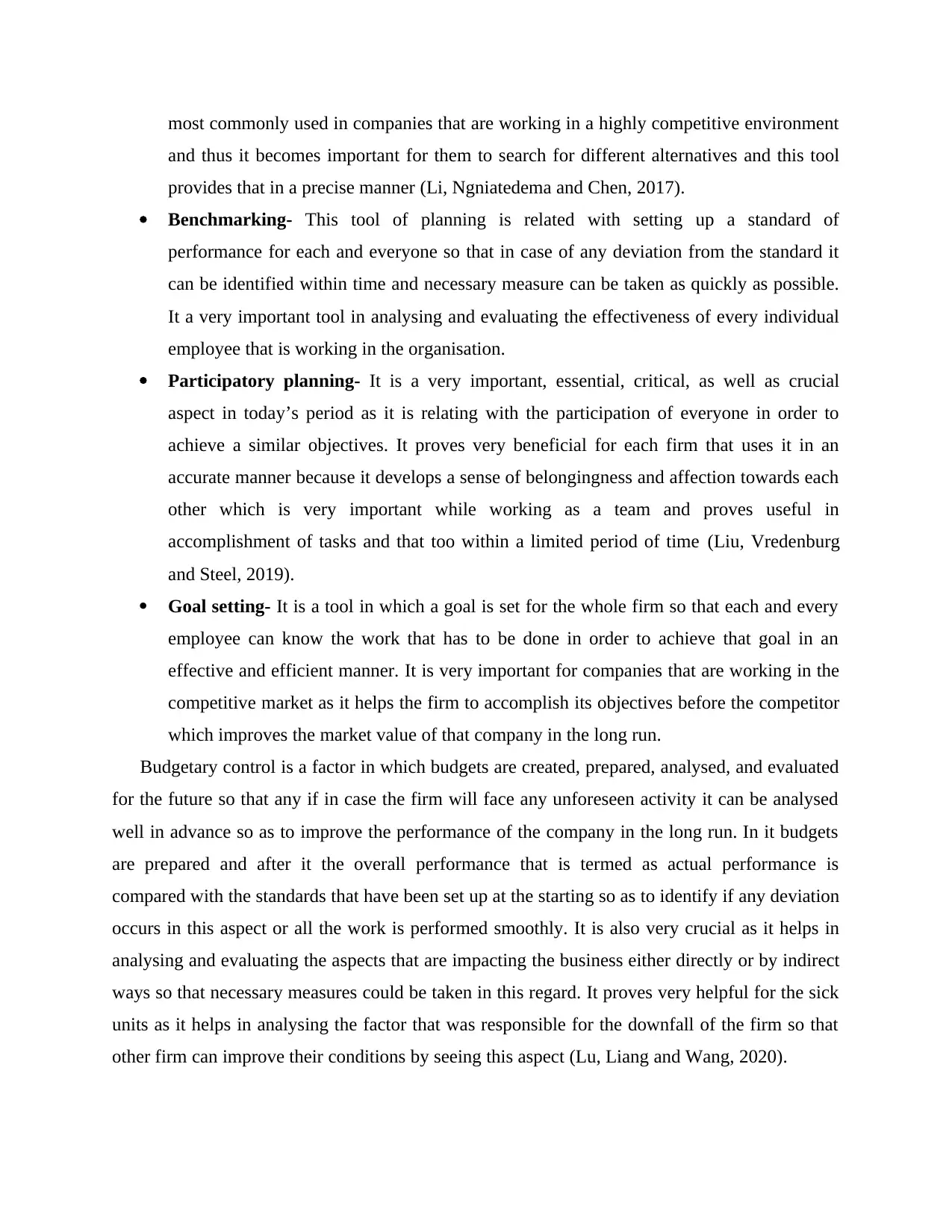
most commonly used in companies that are working in a highly competitive environment
and thus it becomes important for them to search for different alternatives and this tool
provides that in a precise manner (Li, Ngniatedema and Chen, 2017).
Benchmarking- This tool of planning is related with setting up a standard of
performance for each and everyone so that in case of any deviation from the standard it
can be identified within time and necessary measure can be taken as quickly as possible.
It a very important tool in analysing and evaluating the effectiveness of every individual
employee that is working in the organisation.
Participatory planning- It is a very important, essential, critical, as well as crucial
aspect in today’s period as it is relating with the participation of everyone in order to
achieve a similar objectives. It proves very beneficial for each firm that uses it in an
accurate manner because it develops a sense of belongingness and affection towards each
other which is very important while working as a team and proves useful in
accomplishment of tasks and that too within a limited period of time (Liu, Vredenburg
and Steel, 2019).
Goal setting- It is a tool in which a goal is set for the whole firm so that each and every
employee can know the work that has to be done in order to achieve that goal in an
effective and efficient manner. It is very important for companies that are working in the
competitive market as it helps the firm to accomplish its objectives before the competitor
which improves the market value of that company in the long run.
Budgetary control is a factor in which budgets are created, prepared, analysed, and evaluated
for the future so that any if in case the firm will face any unforeseen activity it can be analysed
well in advance so as to improve the performance of the company in the long run. In it budgets
are prepared and after it the overall performance that is termed as actual performance is
compared with the standards that have been set up at the starting so as to identify if any deviation
occurs in this aspect or all the work is performed smoothly. It is also very crucial as it helps in
analysing and evaluating the aspects that are impacting the business either directly or by indirect
ways so that necessary measures could be taken in this regard. It proves very helpful for the sick
units as it helps in analysing the factor that was responsible for the downfall of the firm so that
other firm can improve their conditions by seeing this aspect (Lu, Liang and Wang, 2020).
and thus it becomes important for them to search for different alternatives and this tool
provides that in a precise manner (Li, Ngniatedema and Chen, 2017).
Benchmarking- This tool of planning is related with setting up a standard of
performance for each and everyone so that in case of any deviation from the standard it
can be identified within time and necessary measure can be taken as quickly as possible.
It a very important tool in analysing and evaluating the effectiveness of every individual
employee that is working in the organisation.
Participatory planning- It is a very important, essential, critical, as well as crucial
aspect in today’s period as it is relating with the participation of everyone in order to
achieve a similar objectives. It proves very beneficial for each firm that uses it in an
accurate manner because it develops a sense of belongingness and affection towards each
other which is very important while working as a team and proves useful in
accomplishment of tasks and that too within a limited period of time (Liu, Vredenburg
and Steel, 2019).
Goal setting- It is a tool in which a goal is set for the whole firm so that each and every
employee can know the work that has to be done in order to achieve that goal in an
effective and efficient manner. It is very important for companies that are working in the
competitive market as it helps the firm to accomplish its objectives before the competitor
which improves the market value of that company in the long run.
Budgetary control is a factor in which budgets are created, prepared, analysed, and evaluated
for the future so that any if in case the firm will face any unforeseen activity it can be analysed
well in advance so as to improve the performance of the company in the long run. In it budgets
are prepared and after it the overall performance that is termed as actual performance is
compared with the standards that have been set up at the starting so as to identify if any deviation
occurs in this aspect or all the work is performed smoothly. It is also very crucial as it helps in
analysing and evaluating the aspects that are impacting the business either directly or by indirect
ways so that necessary measures could be taken in this regard. It proves very helpful for the sick
units as it helps in analysing the factor that was responsible for the downfall of the firm so that
other firm can improve their conditions by seeing this aspect (Lu, Liang and Wang, 2020).
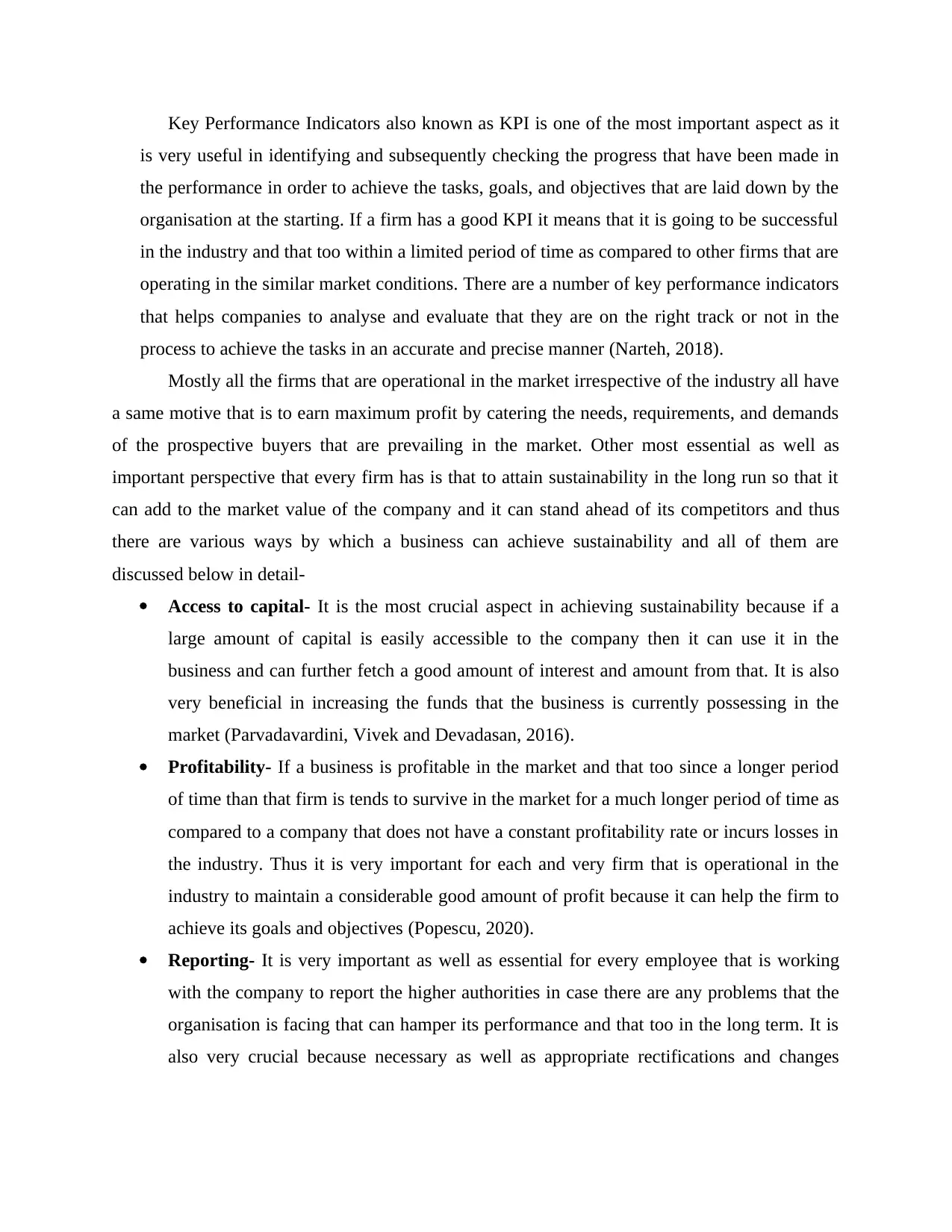
Key Performance Indicators also known as KPI is one of the most important aspect as it
is very useful in identifying and subsequently checking the progress that have been made in
the performance in order to achieve the tasks, goals, and objectives that are laid down by the
organisation at the starting. If a firm has a good KPI it means that it is going to be successful
in the industry and that too within a limited period of time as compared to other firms that are
operating in the similar market conditions. There are a number of key performance indicators
that helps companies to analyse and evaluate that they are on the right track or not in the
process to achieve the tasks in an accurate and precise manner (Narteh, 2018).
Mostly all the firms that are operational in the market irrespective of the industry all have
a same motive that is to earn maximum profit by catering the needs, requirements, and demands
of the prospective buyers that are prevailing in the market. Other most essential as well as
important perspective that every firm has is that to attain sustainability in the long run so that it
can add to the market value of the company and it can stand ahead of its competitors and thus
there are various ways by which a business can achieve sustainability and all of them are
discussed below in detail-
Access to capital- It is the most crucial aspect in achieving sustainability because if a
large amount of capital is easily accessible to the company then it can use it in the
business and can further fetch a good amount of interest and amount from that. It is also
very beneficial in increasing the funds that the business is currently possessing in the
market (Parvadavardini, Vivek and Devadasan, 2016).
Profitability- If a business is profitable in the market and that too since a longer period
of time than that firm is tends to survive in the market for a much longer period of time as
compared to a company that does not have a constant profitability rate or incurs losses in
the industry. Thus it is very important for each and very firm that is operational in the
industry to maintain a considerable good amount of profit because it can help the firm to
achieve its goals and objectives (Popescu, 2020).
Reporting- It is very important as well as essential for every employee that is working
with the company to report the higher authorities in case there are any problems that the
organisation is facing that can hamper its performance and that too in the long term. It is
also very crucial because necessary as well as appropriate rectifications and changes
is very useful in identifying and subsequently checking the progress that have been made in
the performance in order to achieve the tasks, goals, and objectives that are laid down by the
organisation at the starting. If a firm has a good KPI it means that it is going to be successful
in the industry and that too within a limited period of time as compared to other firms that are
operating in the similar market conditions. There are a number of key performance indicators
that helps companies to analyse and evaluate that they are on the right track or not in the
process to achieve the tasks in an accurate and precise manner (Narteh, 2018).
Mostly all the firms that are operational in the market irrespective of the industry all have
a same motive that is to earn maximum profit by catering the needs, requirements, and demands
of the prospective buyers that are prevailing in the market. Other most essential as well as
important perspective that every firm has is that to attain sustainability in the long run so that it
can add to the market value of the company and it can stand ahead of its competitors and thus
there are various ways by which a business can achieve sustainability and all of them are
discussed below in detail-
Access to capital- It is the most crucial aspect in achieving sustainability because if a
large amount of capital is easily accessible to the company then it can use it in the
business and can further fetch a good amount of interest and amount from that. It is also
very beneficial in increasing the funds that the business is currently possessing in the
market (Parvadavardini, Vivek and Devadasan, 2016).
Profitability- If a business is profitable in the market and that too since a longer period
of time than that firm is tends to survive in the market for a much longer period of time as
compared to a company that does not have a constant profitability rate or incurs losses in
the industry. Thus it is very important for each and very firm that is operational in the
industry to maintain a considerable good amount of profit because it can help the firm to
achieve its goals and objectives (Popescu, 2020).
Reporting- It is very important as well as essential for every employee that is working
with the company to report the higher authorities in case there are any problems that the
organisation is facing that can hamper its performance and that too in the long term. It is
also very crucial because necessary as well as appropriate rectifications and changes
⊘ This is a preview!⊘
Do you want full access?
Subscribe today to unlock all pages.

Trusted by 1+ million students worldwide
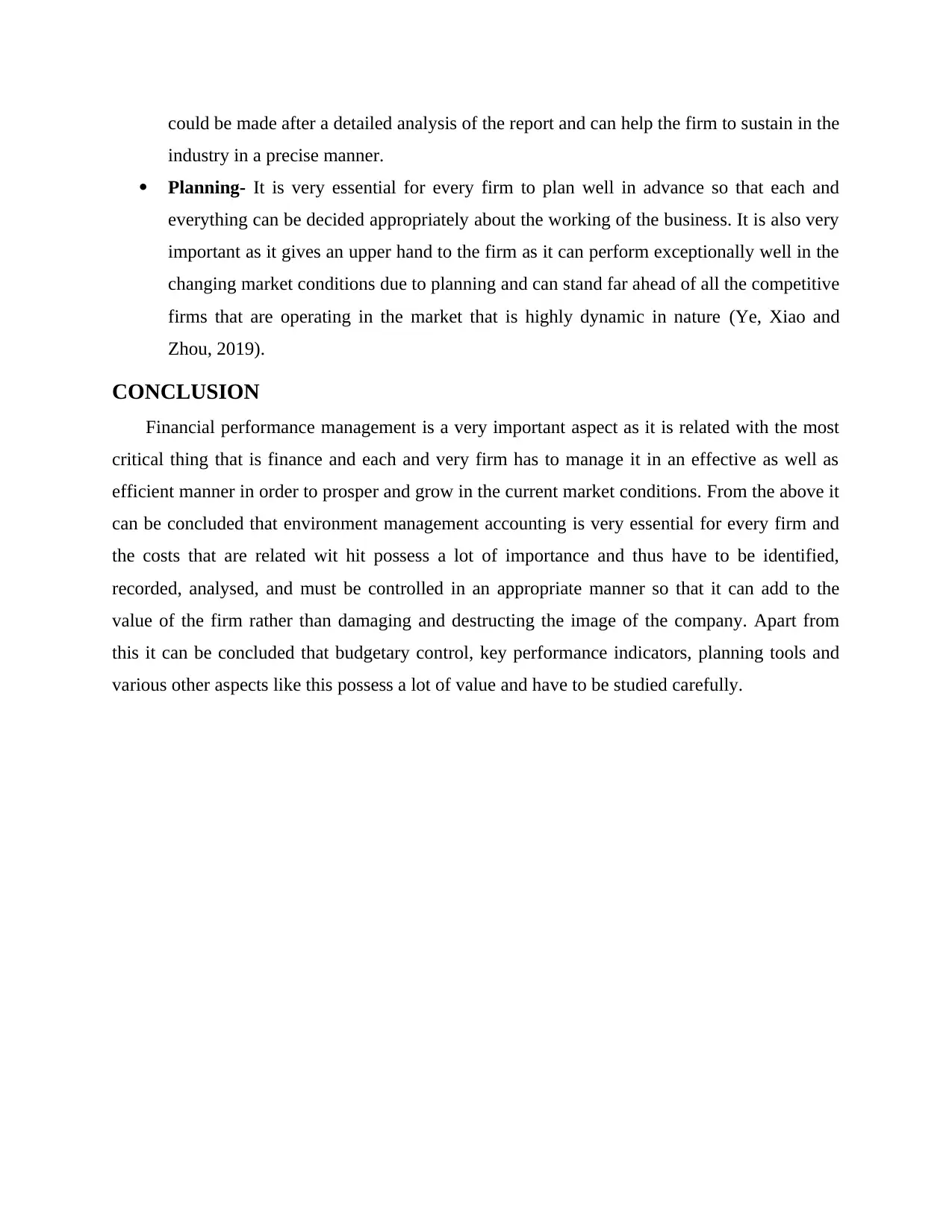
could be made after a detailed analysis of the report and can help the firm to sustain in the
industry in a precise manner.
Planning- It is very essential for every firm to plan well in advance so that each and
everything can be decided appropriately about the working of the business. It is also very
important as it gives an upper hand to the firm as it can perform exceptionally well in the
changing market conditions due to planning and can stand far ahead of all the competitive
firms that are operating in the market that is highly dynamic in nature (Ye, Xiao and
Zhou, 2019).
CONCLUSION
Financial performance management is a very important aspect as it is related with the most
critical thing that is finance and each and very firm has to manage it in an effective as well as
efficient manner in order to prosper and grow in the current market conditions. From the above it
can be concluded that environment management accounting is very essential for every firm and
the costs that are related wit hit possess a lot of importance and thus have to be identified,
recorded, analysed, and must be controlled in an appropriate manner so that it can add to the
value of the firm rather than damaging and destructing the image of the company. Apart from
this it can be concluded that budgetary control, key performance indicators, planning tools and
various other aspects like this possess a lot of value and have to be studied carefully.
industry in a precise manner.
Planning- It is very essential for every firm to plan well in advance so that each and
everything can be decided appropriately about the working of the business. It is also very
important as it gives an upper hand to the firm as it can perform exceptionally well in the
changing market conditions due to planning and can stand far ahead of all the competitive
firms that are operating in the market that is highly dynamic in nature (Ye, Xiao and
Zhou, 2019).
CONCLUSION
Financial performance management is a very important aspect as it is related with the most
critical thing that is finance and each and very firm has to manage it in an effective as well as
efficient manner in order to prosper and grow in the current market conditions. From the above it
can be concluded that environment management accounting is very essential for every firm and
the costs that are related wit hit possess a lot of importance and thus have to be identified,
recorded, analysed, and must be controlled in an appropriate manner so that it can add to the
value of the firm rather than damaging and destructing the image of the company. Apart from
this it can be concluded that budgetary control, key performance indicators, planning tools and
various other aspects like this possess a lot of value and have to be studied carefully.
Paraphrase This Document
Need a fresh take? Get an instant paraphrase of this document with our AI Paraphraser
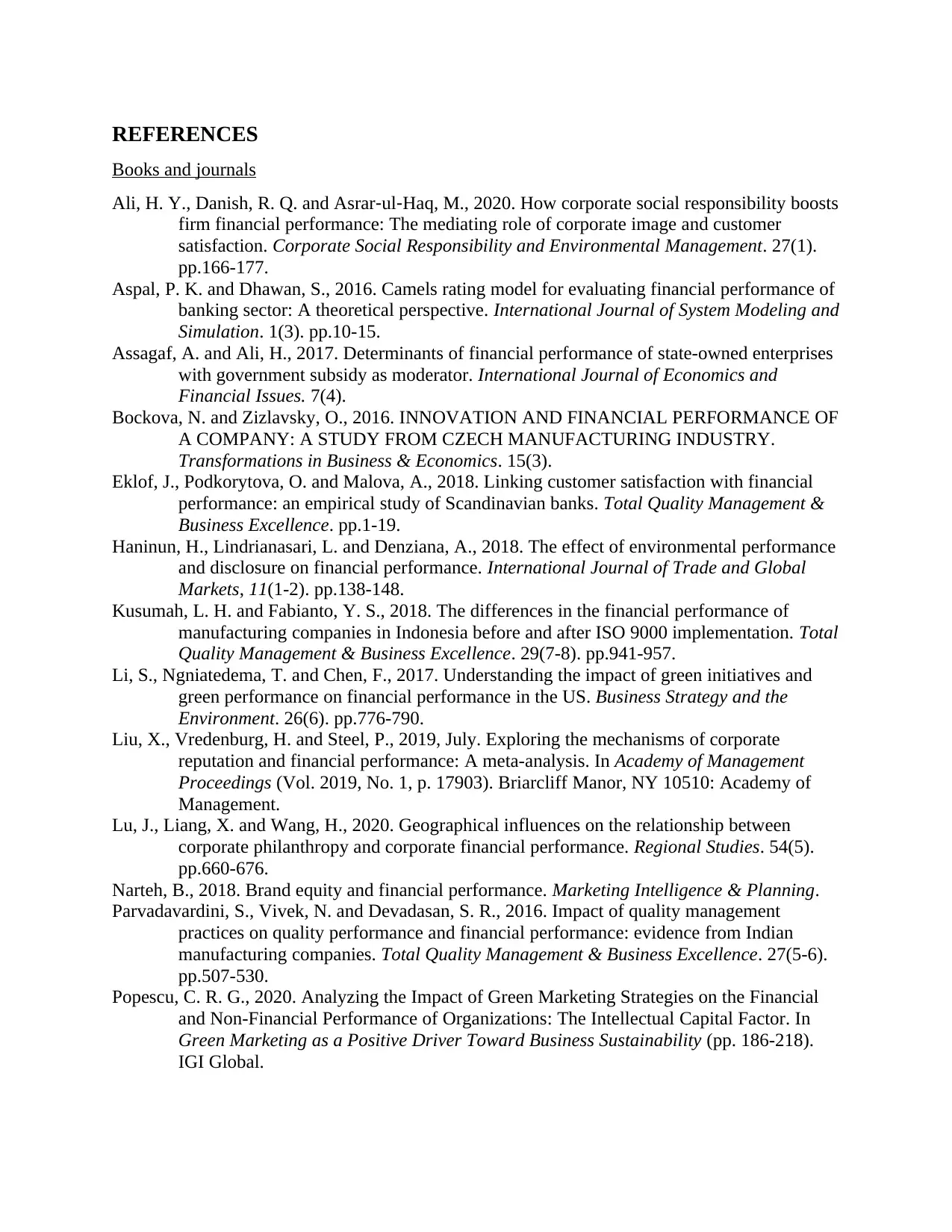
REFERENCES
Books and journals
Ali, H. Y., Danish, R. Q. and Asrar‐ul‐Haq, M., 2020. How corporate social responsibility boosts
firm financial performance: The mediating role of corporate image and customer
satisfaction. Corporate Social Responsibility and Environmental Management. 27(1).
pp.166-177.
Aspal, P. K. and Dhawan, S., 2016. Camels rating model for evaluating financial performance of
banking sector: A theoretical perspective. International Journal of System Modeling and
Simulation. 1(3). pp.10-15.
Assagaf, A. and Ali, H., 2017. Determinants of financial performance of state-owned enterprises
with government subsidy as moderator. International Journal of Economics and
Financial Issues. 7(4).
Bockova, N. and Zizlavsky, O., 2016. INNOVATION AND FINANCIAL PERFORMANCE OF
A COMPANY: A STUDY FROM CZECH MANUFACTURING INDUSTRY.
Transformations in Business & Economics. 15(3).
Eklof, J., Podkorytova, O. and Malova, A., 2018. Linking customer satisfaction with financial
performance: an empirical study of Scandinavian banks. Total Quality Management &
Business Excellence. pp.1-19.
Haninun, H., Lindrianasari, L. and Denziana, A., 2018. The effect of environmental performance
and disclosure on financial performance. International Journal of Trade and Global
Markets, 11(1-2). pp.138-148.
Kusumah, L. H. and Fabianto, Y. S., 2018. The differences in the financial performance of
manufacturing companies in Indonesia before and after ISO 9000 implementation. Total
Quality Management & Business Excellence. 29(7-8). pp.941-957.
Li, S., Ngniatedema, T. and Chen, F., 2017. Understanding the impact of green initiatives and
green performance on financial performance in the US. Business Strategy and the
Environment. 26(6). pp.776-790.
Liu, X., Vredenburg, H. and Steel, P., 2019, July. Exploring the mechanisms of corporate
reputation and financial performance: A meta-analysis. In Academy of Management
Proceedings (Vol. 2019, No. 1, p. 17903). Briarcliff Manor, NY 10510: Academy of
Management.
Lu, J., Liang, X. and Wang, H., 2020. Geographical influences on the relationship between
corporate philanthropy and corporate financial performance. Regional Studies. 54(5).
pp.660-676.
Narteh, B., 2018. Brand equity and financial performance. Marketing Intelligence & Planning.
Parvadavardini, S., Vivek, N. and Devadasan, S. R., 2016. Impact of quality management
practices on quality performance and financial performance: evidence from Indian
manufacturing companies. Total Quality Management & Business Excellence. 27(5-6).
pp.507-530.
Popescu, C. R. G., 2020. Analyzing the Impact of Green Marketing Strategies on the Financial
and Non-Financial Performance of Organizations: The Intellectual Capital Factor. In
Green Marketing as a Positive Driver Toward Business Sustainability (pp. 186-218).
IGI Global.
Books and journals
Ali, H. Y., Danish, R. Q. and Asrar‐ul‐Haq, M., 2020. How corporate social responsibility boosts
firm financial performance: The mediating role of corporate image and customer
satisfaction. Corporate Social Responsibility and Environmental Management. 27(1).
pp.166-177.
Aspal, P. K. and Dhawan, S., 2016. Camels rating model for evaluating financial performance of
banking sector: A theoretical perspective. International Journal of System Modeling and
Simulation. 1(3). pp.10-15.
Assagaf, A. and Ali, H., 2017. Determinants of financial performance of state-owned enterprises
with government subsidy as moderator. International Journal of Economics and
Financial Issues. 7(4).
Bockova, N. and Zizlavsky, O., 2016. INNOVATION AND FINANCIAL PERFORMANCE OF
A COMPANY: A STUDY FROM CZECH MANUFACTURING INDUSTRY.
Transformations in Business & Economics. 15(3).
Eklof, J., Podkorytova, O. and Malova, A., 2018. Linking customer satisfaction with financial
performance: an empirical study of Scandinavian banks. Total Quality Management &
Business Excellence. pp.1-19.
Haninun, H., Lindrianasari, L. and Denziana, A., 2018. The effect of environmental performance
and disclosure on financial performance. International Journal of Trade and Global
Markets, 11(1-2). pp.138-148.
Kusumah, L. H. and Fabianto, Y. S., 2018. The differences in the financial performance of
manufacturing companies in Indonesia before and after ISO 9000 implementation. Total
Quality Management & Business Excellence. 29(7-8). pp.941-957.
Li, S., Ngniatedema, T. and Chen, F., 2017. Understanding the impact of green initiatives and
green performance on financial performance in the US. Business Strategy and the
Environment. 26(6). pp.776-790.
Liu, X., Vredenburg, H. and Steel, P., 2019, July. Exploring the mechanisms of corporate
reputation and financial performance: A meta-analysis. In Academy of Management
Proceedings (Vol. 2019, No. 1, p. 17903). Briarcliff Manor, NY 10510: Academy of
Management.
Lu, J., Liang, X. and Wang, H., 2020. Geographical influences on the relationship between
corporate philanthropy and corporate financial performance. Regional Studies. 54(5).
pp.660-676.
Narteh, B., 2018. Brand equity and financial performance. Marketing Intelligence & Planning.
Parvadavardini, S., Vivek, N. and Devadasan, S. R., 2016. Impact of quality management
practices on quality performance and financial performance: evidence from Indian
manufacturing companies. Total Quality Management & Business Excellence. 27(5-6).
pp.507-530.
Popescu, C. R. G., 2020. Analyzing the Impact of Green Marketing Strategies on the Financial
and Non-Financial Performance of Organizations: The Intellectual Capital Factor. In
Green Marketing as a Positive Driver Toward Business Sustainability (pp. 186-218).
IGI Global.

Ye, S., Xiao, H. and Zhou, L., 2019. Small accommodation business growth in rural areas:
Effects on guest experience and financial performance. International Journal of
Hospitality Management. 76. pp.29-38.
Effects on guest experience and financial performance. International Journal of
Hospitality Management. 76. pp.29-38.
⊘ This is a preview!⊘
Do you want full access?
Subscribe today to unlock all pages.

Trusted by 1+ million students worldwide
1 out of 12
Related Documents
Your All-in-One AI-Powered Toolkit for Academic Success.
+13062052269
info@desklib.com
Available 24*7 on WhatsApp / Email
![[object Object]](/_next/static/media/star-bottom.7253800d.svg)
Unlock your academic potential
Copyright © 2020–2025 A2Z Services. All Rights Reserved. Developed and managed by ZUCOL.





